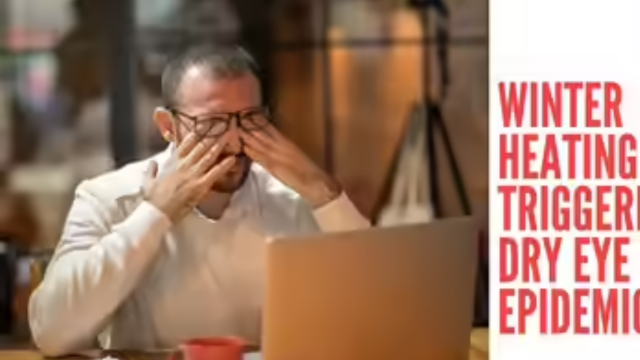November 20, 2025 : Doctors across Delhi and the National Capital Region (NCR) have issued a serious warning about what they are calling a “Dry Eye Epidemic”, triggered largely by the increased use of indoor heating systems during the harsh winter months. As temperatures continue to drop, households, workplaces, and commercial spaces have begun relying heavily on room heaters, blowers, and HVAC systems—creating an environment that is warm but extremely low in humidity, a major culprit behind rising cases of dry eye disease.
According to leading ophthalmologists in the city, winter already tends to worsen eye dryness due to reduced tear evaporation and the effects of cold winds. However, this year’s spike has been unprecedented. Doctors report a 40–60% increase in patients complaining of eye irritation, burning sensations, itchiness, redness, and blurred vision—classic symptoms of Dry Eye Syndrome.
Indoor Heating: The Silent Trigger
While heaters make indoor spaces more comfortable during winter, they significantly reduce moisture in the air. This low humidity environment causes the tears on the eye surface to evaporate quickly, leading to dryness, inflammation, and discomfort.
Doctors note that blower-type heaters are particularly harmful, as they release hot air at high speed directly into the room, rapidly dropping humidity levels. Even air conditioners used in heating mode contribute to the problem.
Many Delhi residents are unaware that such heating systems are damaging their tear film, making symptoms worse in those already prone to dry eye—especially office workers, students, elderly individuals, and people who spend long hours on screens.
Who Is at Highest Risk?
Experts say the dry eye surge is most prevalent among:
- Office workers exposed to AC/heaters and long screen hours
- Students attending online classes or studying indoors
- Senior citizens with naturally reduced tear production
- Contact lens users, who already experience tear film disruption
- People with diabetes or autoimmune conditions
Doctors say that the combination of dry winter air, screen exposure, and indoor heating has created a perfect storm for the widespread rise in dry eye disease.
Doctors Report a Spike in Cases
Ophthalmology departments across Delhi’s major hospitals—including AIIMS, Safdarjung, Gangaram, and private eye clinics—report overcrowded outpatient departments with patients experiencing severe discomfort.
Symptoms include:
- Persistent dryness
- Gritty or sandy feeling in the eyes
- Excessive tearing (a reflex response to dryness)
- Light sensitivity
- Swollen or irritated eyelids
- Difficulty wearing contact lenses
- Fluctuating blurry vision
Some patients also experience inflammation of the cornea, which, if untreated, may lead to more serious complications.
Screen Time Makes It Worse
Doctors emphasize that screen exposure during winter amplifies the problem. Studies show that individuals blink 60% less while using digital devices, causing tears to evaporate even faster.
With people spending more time indoors to avoid pollution and cold waves, screen usage naturally increases—compounding dry eye symptoms.
How to Prevent Dry Eyes During Winter
To help residents cope with this seasonal epidemic, doctors have shared six practical prevention tips:
1. Use a Humidifier Indoors
A humidifier restores moisture in the air and significantly reduces tear evaporation.
Even placing bowls of water near heaters can help raise humidity levels.
2. Follow the 20-20-20 Rule
Every 20 minutes, look at something 20 feet away for 20 seconds.
This encourages blinking and relaxes eye muscles.
3. Avoid Direct Hot Air From Heaters
Do not sit right in front of heaters or blowers.
Choose oil-filled radiators or humidified heating systems.
4. Use Lubricating Eye Drops
Preservative-free artificial tears help maintain the tear film.
Doctors recommend using them 2–4 times a day during winter.
5. Blink Consciously During Screen Use
Remind yourself to blink fully to prevent tear evaporation.
6. Stay Hydrated and Eat Omega-3 Rich Foods
Water, nuts, fish, and flaxseeds help improve natural tear production.
When to See a Doctor
Doctors advise seeking medical help if symptoms:
- Persist for more than a week
- Cause pain, redness, or blurred vision
- Do not improve with home remedies
Untreated dry eye can lead to corneal complications, chronic discomfort, and long-term vision issues.
Conclusion
Delhi’s winter dry eye crisis is a growing public health concern, made worse by indoor heating, increased screen exposure, and low humidity. Doctors urge residents to be proactive in protecting their eye health by maintaining indoor moisture, taking screen breaks, and using lubricating drops. With awareness and preventive care, this seasonal epidemic can be controlled—before it evolves into a year-round problem.
Summary
Delhi doctors warn of a Dry Eye Epidemic triggered by indoor heating and low humidity during winter. Rising cases show severe dryness, irritation, and vision issues. Experts suggest humidifiers, screen breaks, and eye drops for prevention.


